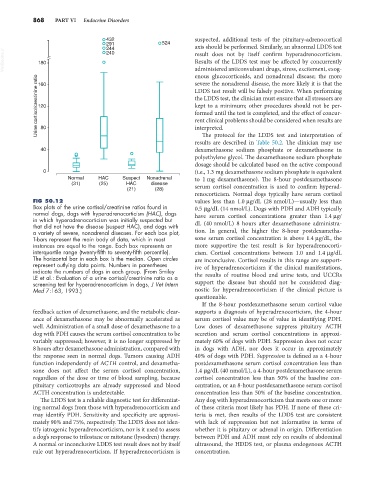Page 896 - Small Animal Internal Medicine, 6th Edition
P. 896
868 PART VI Endocrine Disorders
432 suspected, additional tests of the pituitary-adrenocortical
291 524 axis should be performed. Similarly, an abnormal LDDS test
244
VetBooks.ir 180 240 result does not by itself confirm hyperadrenocorticism.
Results of the LDDS test may be affected by concurrently
administered anticonvulsant drugs, stress, excitement, exog-
enous glucocorticoids, and nonadrenal disease; the more
Urine cortisol/creatinine ratio 160 LDDS test result will be falsely positive. When performing
severe the nonadrenal disease, the more likely it is that the
the LDDS test, the clinician must ensure that all stressors are
kept to a minimum; other procedures should not be per-
120
formed until the test is completed, and the effect of concur-
rent clinical problems should be considered when results are
interpreted.
80
The protocol for the LDDS test and interpretation of
results are described in Table 50.2. The clinician may use
40 dexamethasone sodium phosphate or dexamethasone in
polyethylene glycol. The dexamethasone sodium phosphate
dosage should be calculated based on the active compound
0 (i.e., 1.3 mg dexamethasone sodium phosphate is equivalent
Normal HAC Suspect Nonadrenal to 1 mg dexamethasone). The 8-hour postdexamethasone
(31) (25) HAC disease
(21) (28) serum cortisol concentration is used to confirm hyperad-
renocorticism. Normal dogs typically have serum cortisol
FIG 50.12 values less than 1.0 µg/dL (28 nmol/L)—usually less than
Box plots of the urine cortisol/creatinine ratios found in 0.5 µg/dL (14 nmol/L). Dogs with PDH and ADH typically
normal dogs, dogs with hyperadrenocorticism (HAC), dogs have serum cortisol concentrations greater than 1.4 µg/
in which hyperadrenocorticism was initially suspected but
that did not have the disease (suspect HAC), and dogs with dL (40 nmol/L) 8 hours after dexamethasone administra-
a variety of severe, nonadrenal diseases. For each box plot, tion. In general, the higher the 8-hour postdexametha-
T-bars represent the main body of data, which in most sone serum cortisol concentration is above 1.4 µg/dL, the
instances are equal to the range. Each box represents an more supportive the test result is for hyperadrenocorti-
interquartile range (twenty-fifth to seventy-fifth percentile). cism. Cortisol concentrations between 1.0 and 1.4 µg/dL
The horizontal bar in each box is the median. Open circles are inconclusive. Cortisol results in this range are support-
represent outlying data points. Numbers in parentheses ive of hyperadrenocorticism if the clinical manifestations,
indicate the numbers of dogs in each group. (From Smiley
LE et al.: Evaluation of a urine cortisol/creatinine ratio as a the results of routine blood and urine tests, and UCCRs
screening test for hyperadrenocorticism in dogs, J Vet Intern support the disease but should not be considered diag-
Med 7:163, 1993.) nostic for hyperadrenocorticism if the clinical picture is
questionable.
If the 8-hour postdexamethasone serum cortisol value
feedback action of dexamethasone, and the metabolic clear- supports a diagnosis of hyperadrenocorticism, the 4-hour
ance of dexamethasone may be abnormally accelerated as serum cortisol value may be of value in identifying PDH.
well. Administration of a small dose of dexamethasone to a Low doses of dexamethasone suppress pituitary ACTH
dog with PDH causes the serum cortisol concentration to be secretion and serum cortisol concentrations in approxi-
variably suppressed; however, it is no longer suppressed by mately 60% of dogs with PDH. Suppression does not occur
8 hours after dexamethasone administration, compared with in dogs with ADH, nor does it occur in approximately
the response seen in normal dogs. Tumors causing ADH 40% of dogs with PDH. Suppression is defined as a 4-hour
function independently of ACTH control, and dexametha- postdexamethasone serum cortisol concentration less than
sone does not affect the serum cortisol concentration, 1.4 µg/dL (40 nmol/L), a 4-hour postdexamethasone serum
regardless of the dose or time of blood sampling, because cortisol concentration less than 50% of the baseline con-
pituitary corticotrophs are already suppressed and blood centration, or an 8-hour postdexamethasone serum cortisol
ACTH concentration is undetectable. concentration less than 50% of the baseline concentration.
The LDDS test is a reliable diagnostic test for differentiat- Any dog with hyperadrenocorticism that meets one or more
ing normal dogs from those with hyperadrenocorticism and of these criteria most likely has PDH. If none of these cri-
may identify PDH. Sensitivity and specificity are approxi- teria is met, then results of the LDDS test are consistent
mately 90% and 75%, respectively. The LDDS does not iden- with lack of suppression but not informative in terms of
tify iatrogenic hyperadrenocorticism, nor is it used to assess whether it is pituitary or adrenal in origin. Differentiation
a dog’s response to trilostane or mitotane (lysodren) therapy. between PDH and ADH must rely on results of abdominal
A normal or inconclusive LDDS test result does not by itself ultrasound, the HDDS test, or plasma endogenous ACTH
rule out hyperadrenocorticism. If hyperadrenocorticism is concentration.

